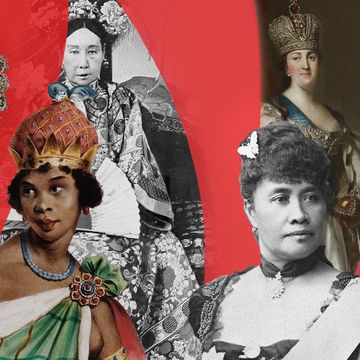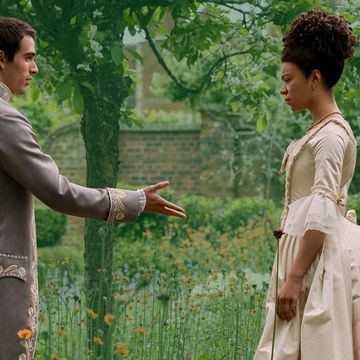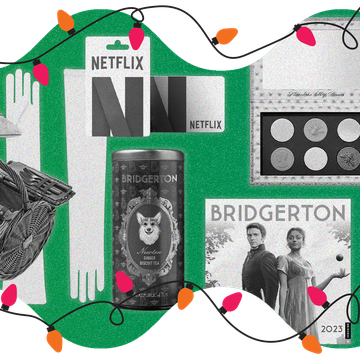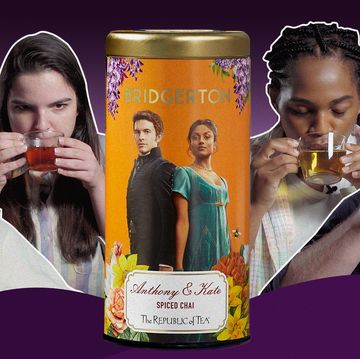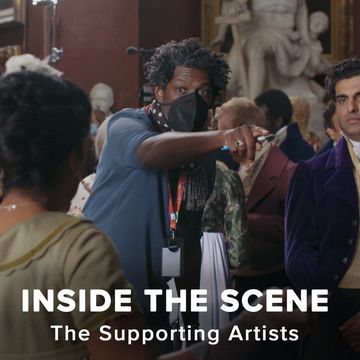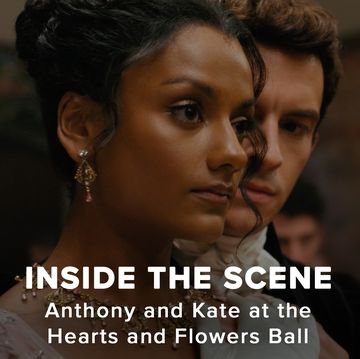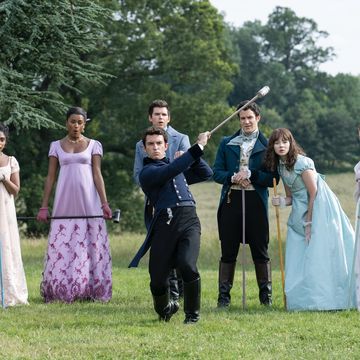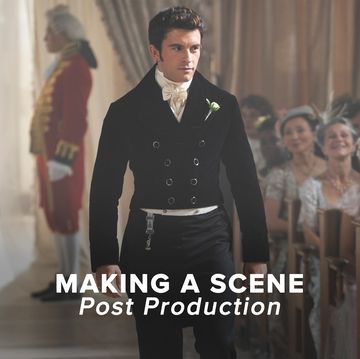There’s no denying that humans love gossip. We want to know what’s going on, where it happened, and whom it happened to — especially when we aren’t directly involved. Our cultural obsession with gossip isn’t new, as Bridgerton’s Lady Whistledown reveals, and it hasn’t just existed since the advent of the tabloid newspaper. In fact, people have been gossiping about one another for centuries. And while gossip can be malicious, it doesn’t necessarily have to be negative — sometimes we pass along positive information — and gossiping can actually have real benefit to our lives.
A study published in the Journal of Personality and Social Psychology in 2012 found that when subjects actively gossiped about a person or situation, it soothed them and brought their heart rates down. Matthew Feinberg, an assistant professor of organizational behavior at the University of Toronto’s Rotman School of Management, and one of the people who helmed the study, explained that the act of gossiping “helps calm the body.” That certainly explains our ongoing obsession with celebrity relationships and your avid interest in whatever your weird neighbor was up to during lockdown. But how did we get here?
While gossip has been social currency since the dawn of time, actual written gossip columns have not. A gossip column, defined as a section of a newspaper or magazine where the activities and private lives of notable people are discussed, is a relatively new invention that coincided with the arrival of the printing press and mass printing. There are instances of early published gossip, including in London newspapers in the 17th century, but it was really the 18th century that saw the vast dissemination of gossip throughout society in Europe.
Between 1777 and 1783, a writer named James Boswell wrote around 70 columns under the name “The Hypochondriack” in the London Magazine, commenting on all sorts of goings-on, including the news of public hangings. By the time of the Regency era — in which the second season of Bridgerton takes place — newspapers, pamphlets, and magazines were quite common, and many included regular gossip reporting. It was a way to detail the intrigues of the ton, as well as the lives of politicians, who were part of that upper class.
“Gossip and scandal was part of the currency of news at the time,” explains Bridgerton historical adviser Hannah Greig. “The conduct of members of the beau monde was scrutinized in the press in the same way that we comment on the behavior of celebrities today. Daily London newspapers carried gossip columns, and from the mid-18th century onward, [so] did monthly periodicals such as The World, The Connoisseur, and Le Bon Ton, which focused on the adventures, conduct, and fashions of the fashionable world. For the Town and Country magazine, sexual scandals were big business, with details of the ton’s love affairs published in their monthly ‘Tête-à-Tête’ feature in the closing decades of the 18th century.”
Unlike Lady Whistledown, however, the columnists and writers, many of whom were anonymous, didn’t typically reveal whom exactly they were talking about. “The actual names of the individuals in question were redacted and replaced with initials or a suggestive pseudonym, but the articles included portraits of the protagonists, and their identities were easily determined by the news-hungry public,” Greig notes. “So, if it’s [about] Anthony Bridgerton, it might just be in a scandal sheet as ‘the Viscount B.’ His whole name wouldn’t be given.”
This increase in the sheer amount of gossip and information occurred for two main reasons: One, printing was more easily accessible. And two, the libel laws in England became far looser during the Regency era. Printing was so widespread that every local town had its own newspaper. Anyone could have printed something, for the right price, so even you could have been Lady Whistledown.
“It was a time when newspapers had become really widely available due to the revolution in printing and how quickly people could produce these papers,” Greig says. “And also because there was a relaxation of the licensing laws, so people were no longer so liable to libel allegations. The control of the print culture changed. There was a massive explosion of newspaper culture, of publications of pamphlets — it was a world of paper, basically. And you needed information to put in there. It was a kind of journalistic heyday.”
Around the same time, writers began penning what is now called the “silver fork novel” — essentially an early version of the Regency romance novel. These books, which boomed around the 1810s and 1820s, were both based on real-life people and events and drawn from fictional circumstances. They were sort of like longer gossip columns. One of the most famous was Almack’s: A Society Novel of the Times of George IV by Marianne Spencer Hudson, published in 1826.
“In the early 1800s, the loves and lives of fashionable figures were a hugely popular topic within society novels,” notes Greig. “Many were ‘roman à clef’ novels that were drawn from life but presented as fiction, with clues given as to the true identities of the characters depicted. They were set within the Regency world, charting the pressures of the marriage market and the fate and fortune of various members of London’s beau monde.”
The love of gossip during the Regency era continued throughout the 19th century, with the latter part of the era spawning many of the publications that feed us gossip today — The Daily Mail, for instance, was founded in 1896. A similar obsession consumed this side of the Atlantic, as well. The New York Post, founded by Alexander Hamilton, has been around since 1801, although its infamous Page Six — which reports on the not-always-pleasant happenings of celebrities — launched by James Brady, emerged much later, in the 1970s.
But of course, it was the 20th century that transformed gossip into what it is today: based around movie stars and celebrities. The 1930s and the 1940s saw a serious influx of gossip columns, which coincided with the boom of Hollywood. Walter Winchell published a famous column called “On Broadway” that was filled with rumors about celebrities. Hedda Hopper and Louella Parsons were two of Hollywood’s favorite gossip columnists during the so-called Hollywood Golden Age, with film studios planting items to help publicize their stars and movies. “Hedda Hopper’s Hollywood” debuted in the Los Angeles Times in 1938 and broke big news about extremely notable people, including when President Franklin Roosevelt’s son James was caught having an affair. She was so involved in the lives of the elite that many celebrities actually disliked her. According to Kirk Douglas’ memoir, Elizabeth Taylor was once so fed up with Hopper, she quipped, “Hedda, why don’t you just shut the f--k up?”
In the past few decades, Hollywood has had a similarly contentious relationship with gossip writers, many of whom have become more widespread thanks to the internet and social media. While the 1980s and 1990s were defined by print columns like Page Six and magazines like Us Weekly and People, the 2000s saw a shift to TV and online reporting. TMZ emerged, for better or worse, in 2005.
It was also the era of the gossip blog: Perez Hilton’s iconic blog, named after tabloid mainstay Paris Hilton, came online in 2004, while Just Jared, run by Jared Eng, popped up in 2005. A few other favorites: Oh No They Didn’t, a popular LiveJournal gossip community founded in 2004; Lainey Gossip, run by Elaine “Lainey” Lui; and Gawker, started by journalist Nick Denton in 2002, which also often dissected the happenings of the New York media scene.
While these sites set the stage for modern gossip reporting, today gossip is everywhere, all the time. It’s impossible to avoid it, with countless websites now in existence that report and re-report every celebrity tidbit that happens on camera and off. Thankfully, though, there’s far less appetite for the snark — and, frankly, outright misogyny and verbal abuse — that typified earlier celebrity blogs. Much of the celebrity coverage these days is done with slightly more respect than it was in the 2000s. Alyssa Shelasky, a writer for New York magazine and author of the upcoming book This Might Be Too Personal, has seen some notable shifts since she started writing for gossip magazines.
“We were covering real movie stars: Bennifer, Brad and Jen’s breakup, TomKat,” Shelasky recalls. “Reality stars weren’t really a thing, other than maybe Paris Hilton. I remember covering the first season of The Apprentice, and it was like, ‘Wait, WTF?’ I’m a huge Bravo fan now, but I can’t imagine getting any thrills out of interviewing, like, Luann de Lesseps in comparison to hanging out with Naomi Campbell and her publicist at her penthouse apartment.”
Dorothy Lucey, a former co-host of Good Day L.A., has also noticed an uptick in the amount of celebrity news and gossip covered by the media. Lucey joined the morning show in 1995 and stayed until 2012, during which time the TV program covered more and more gossip.
“At Good Day L.A., we looked forward to Tabloid Thursday, then added Us Weekly Wednesday, then every day became Tabloid Thursday,” Lucey remembers. “There is just something delicious about being the first to say, ‘Did you know …?’ We love to know something unknowable. And since we all live in a 24-hour news cycle, at least part of that news should be a bit of fun. Bridgerton reveals (in very fancy clothing) something we have always known: We love knowing what we probably should not.”
So, while Lady Whistledown may be a fictional character, she represents a universal truth: We’re obsessed with the details of the lives of others, especially if they are scandalous or exciting. “It’s pure escapism,” Shelasky notes. “It’s delicious. Scandalous. Aspirational. Interesting. It’s everything we need for short bursts of delight and enjoyment in this otherwise stressful world.”
Emily Zemler is a freelance writer and journalist based in London. She regularly contributes to the Los Angeles Times, Rolling Stone, PureWow, and TripSavvy, and is the author of two books. Follow her on Twitter @emilyzemler.
Get Shondaland directly in your inbox: SUBSCRIBE TODAY






